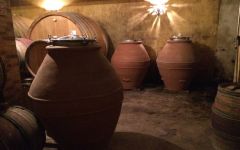Domaine Santa Duc Les Saintes Vierges Chateauneuf-du-Pape 2019
-
Jeb
Dunnuck -
Wine
Spectator



Product Details
Your Rating
Somm Note
Winemaker Notes
Professional Ratings
-
Jeb Dunnuck
The 2019 Châteauneuf Du Pape Les Saintes Vierges is another beautiful wine. Ripe cherries, blueberries, rose petals, spice, and hints of spring flowers all emerge on the nose, and it shines on the palate for its beautiful elegance and purity. Medium to full-bodied, with ripe, polished tannins and notable freshness, it's going to evolve for 15 years with no issues.
-
Wine Spectator
This has a good, gutsy feel, with juicy and still slightly compact plum, raspberry and blackberry fruit flavors taking the lead, while licorice root, apple wood and dried garrigue hints fill in as well. Shows more oomph than purity, but this is solidly built. Grenache, Mourvèdre and Counoise. Best from 2024.








Rising as a pillar of quality out of Gigondas’ soils is Domaine Santa Duc – an estate with a history that stretches back to 1874. Through six generations, the domaine’s caretakers have demonstrated a respect for the land. Santa Duc ascended to prominence starting in 1985 as a pioneer of organic viticulture in the region under the care of its indomitable vigneron, Yves Gras. In the 2017 vintage, Gras’ son Benjamin assumed the helm at Domaine Santa Duc, making his mark immediately by introducing biodynamic farming techniques and constructing a new winemaking facility on the property.
In his time at the head of the estate, Yves branched out to nearby Châteauneuf-du-Pape and Rasteau, creating wines of exceptional balance and quality. He seamlessly integrated fruit from each distinct soil type into harmonious cuvées representing the Southern Rhône Valley’s unique terroir.
The estate wines are Ecocert-certified organic and Demeter-certified biodynamic. Working exclusively with indigenous yeast, the wines are partially destemmed depending on vintage and parcel and aged for 18 months in 36-hectoliter oak Stockinger foudres and 8-hectoliter terracotta amphorae. This estate integrates a thoughtful simplicity to the craft of winemaking that results in beautiful purity of expression in the elegant, focused, and polished wines.

With bold fruit flavors and accents of sweet spice, Grenache, Syrah and Mourvèdre form the base of the classic Rhône Red Blend, while Carignan, Cinsault and Counoise often come in to play. Though they originated from France’s southern Rhône Valley, with some creative interpretation, Rhône blends have also become popular in other countries. Somm Secret—Putting their own local spin on the Rhône Red Blend, those from Priorat often include Merlot and Cabernet Sauvignon. In California, it is not uncommon to see Petite Sirah make an appearance.

Famous for its full-bodied, seductive and spicy reds with flavor and aroma characteristics reminiscent of black cherry, baked raspberry, garrigue, olive tapenade, lavender and baking spice, Châteauneuf-du-Pape is the leading sub-appellation of the southern Rhône River Valley. Large pebbles resembling river rocks, called "galets" in French, dominate most of the terrain. The stones hold heat and reflect it back up to the low-lying gobelet-trained vines. Though the galets are typical, they are not prominent in every vineyard. Chateau Rayas is the most obvious deviation with very sandy soil.
According to law, eighteen grape varieties are allowed in Châteauneuf-du-Pape and most wines are blends of some mix of these. For reds, Grenache is the star player with Mourvedre and Syrah coming typically second. Others used include Cinsault, Counoise and occasionally Muscardin, Vaccarèse, Picquepoul Noir and Terret Noir.
Only about 6-7% of wine from Châteauneuf-du-Pape is white wine. Blends and single-varietal bottlings are typically based on the soft and floral Grenache Blanc but Clairette, Bourboulenc and Roussanne are grown with some significance.
The wine of Chateauneuf-du-Pape takes its name from the relocation of the papal court to Avignon. The lore says that after moving in 1309, Pope Clément V (after whom Chateau Pape-Clément in Pessac-Léognan is named) ordered that vines were planted. But it was actually his successor, John XXII, who established the vineyards. The name however, Chateauneuf-du-Pape, translated as "the pope's new castle," didn’t really stick until the 19th century.
